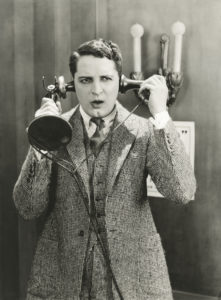Very Rudimentary
{3 minutes to read} On March 10, 1876, Alexander Graham Bell, inventor of the telephone, made the world’s first phone call to his assistant, Thomas Watson. He did not say, “Please check the attachment in the email I just sent you, forward it to Mr. Smith in London, and we’ll all talk via Skype at 2 pm ET. Also, check out the photos of my granddaughter that I texted you. Isn’t she a cutie?”
I used to think that in-person mediation always worked best because having everyone in the same place (not necessarily the same room) at the same time forced people to address the dispute in a focused manner. People were present. They had set aside the day, or at least several hours, for one thing only, and they were face to face with the mediator and at times the other side. It meant everyone got down to business. The mediation itself forced people to grapple with issues in a way they probably would not have if their lawyers were just on their own, figuring out ways to “screw the other side” at a hefty hourly rate.
I still think there’s a lot to be said for physical presence. But I have come to appreciate that much can be accomplished when people are physically far apart. Indeed, there may even be some benefit.
I was recently speaking to a mediator friend who told me she was doing “international mediations” via Skype or Zoom, and they were working out very well. Most of these were divorce matters, and she made a very interesting observation regarding spouses who weren’t exactly best friends anymore: While animosity still got expressed during the mediation, she found that because the parties saw themselves while they were talking, they tended to tone things down a bit more quickly than they typically did when in the same room with the estranged partner. Her initial concern about video conferencing was that she would be unable to observe the body language of the parties. Such visual observations can be important to the mediator, who can learn from them a party’s reactions to what’s being said. However, what my mediator friend hadn’t known was that parties seeing themselves while they talked could actually improve communications because while anger, for example, could still be expressed, it was less likely to get out of hand and hinder dialogue.
You can think of it as the Heisenberg Principle of Mediation. Participants in a mediation who observe themselves change their behavior, and for the better. Seeing themselves, people were better-mannered, which makes sense. One of our greatest fears is being caught saying or doing something we wouldn’t want others to know we said or did.
I have had success in the past doing phone mediations, though usually after having met the parties in person on at least one prior occasion. One employment case got resolved after a final 12-hour round of phone calls back and forth with plaintiff and her counsel in London, defendant’s local counsel in New York, and defendant’s corporate counsel in the Midwest. It was 2 a.m. in London when the deal got sealed. But it happened. And for all I know half of the people on the calls were wearing pajamas by the end.
 |
Gary Shaffer Shaffer MediationGary@ShafferMediation.com |

